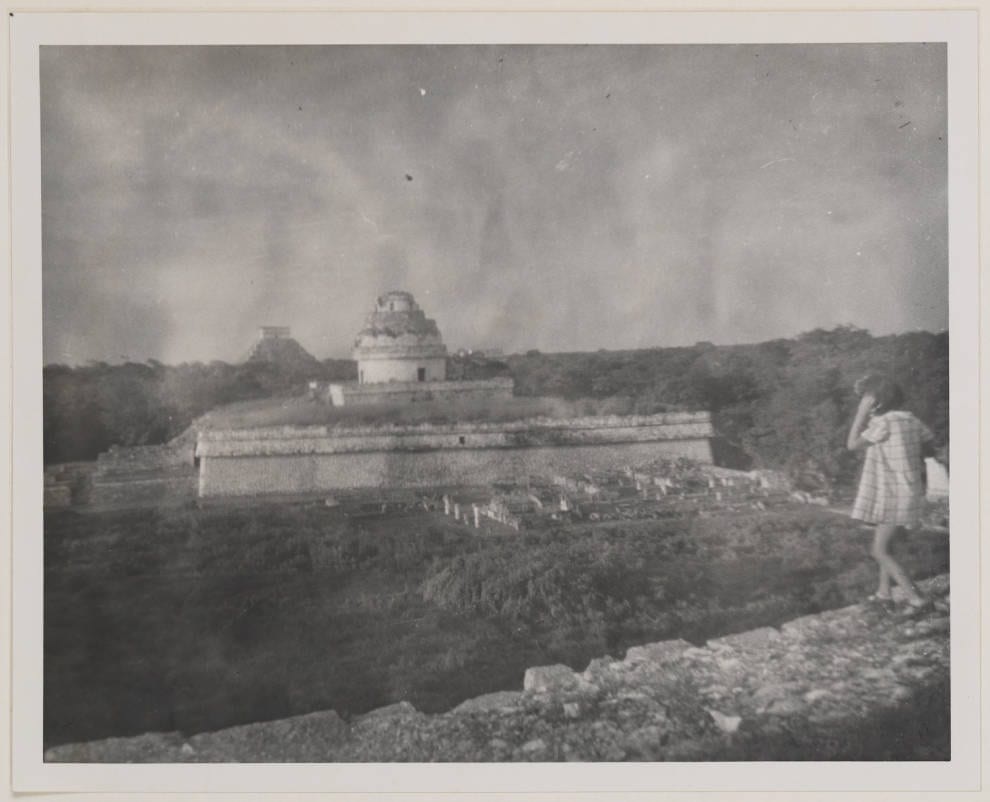Please stop by the second-floor gallery outside of Bywaters Special Collections and view how the portfolio XTOL by Octavio Medellin was researched by the artist in 1938 and later published in 1947 by the Dallas Museum of Fine Arts, which preceded the Dallas Museum of Art. Work began in 1938 when Octavio Medellin spent six months studying the Mayan ruins at Chichén Itzá and Uxmal, located on the Yucatán in Mexico, and documented his travels with 181 black and white photographs that he compiled into a scrapbook entitled Maya – Toltec, Temples and Carvings, 1938 [all photographs in the exhibition are reproductions].

Medellin and his wife, Consuelo, and their two young children, Patsy and Sergio, traveled from New Orleans to Progreso, Yucatán, and toured other towns and historical sites, including Mérida and Izamal, with fellow American artist and sculptor, David Slivka, and his wife, Kayla. Their final destination was Pisté, close to the Chichén Itzá archeological site. The Medellins and Slivkas stayed in Pisté for three months as guests of the local residents but were later invited by Dr. Sylvanus Morley to stay at the Carnegie Institution research center, located next to the ruins at Chichén Itzá. In 1913, Dr. Morley had been instrumental in initiating and directing the first Chichén Itzá project, funded by the Carnegie Institution of Washington. Due to the Mexican Revolution and World War I, the excavations did not start until the 1920s. The Carnegie Institution continued to support excavations at the site until the 1940s.
The photographs in the scrapbook contain images of Medellin’s travels in Mexico, his family, the ruins at Chichén Itzá, people associated with the ancient Mayan sites, and his art and travel friends, David and Kayla Slivka. Several photographs towards the end of the scrapbook, which begin on page 85, are of the Mayan site at Uxmal. One photograph is that of Mrs. Marrufo [first name unknown] and her daughter, Ophelia Marrufo. Mrs. Marrufo’s father was Edward Herbert Thompson, who was an archeologist and U. S. Consul in the Yucatán in 1885. In 1894, with the assistance of a Chicago patron, Mr. Allison V. Armour, Thompson purchased the land that included Chichén Itzá and the old Hacienda Chichén. Thompson rebuilt the hacienda that would later become the compound for the Carnegie Institution research center established by Dr. Morley. Thompson is known for dredging the Cenote Sagrado, a natural sink hole at Chichén Itzá that the Mayans considered to be a sacred well, from 1904 to 1910. Mayan artifacts were found, including items made of gold, copper, and jade.

In 1947, Octavio Medellin’s drawings were developed into the portfolio XTOL – Dance of the Ancient Mayan People, published by the Dallas Museum of Fine Arts. The images were taken from the first register of the bas-relief carvings in the Lower Temple of the Jaguars [or “Tigers”] at Chichén Itzá. Jerry Bywaters, director of the Museum, wrote the text for the prints, entitled “Murals from the Temple of the Tigers.” Salvador Toscano, head of the Department of Fine Arts for Public Education in Mexico, provided an additional essay entitled “A Note on the Murals by Salvador Toscano.” The portfolio consists of ten two-color prints; Medellin drew and cut the blocks for printing. Dallas artist, Dan Wingren, pulled the one five-color silkscreen print. One hundred copies were printed; each portfolio is signed and numbered by Octavio Medellin. Medellin dedicated the portfolio to San Antonio art patron Lucy Maverick, who had encouraged the young artist to return to his native Mexico to study the Mayan ruins. Maverick had traveled in Mexico in the 1920s and became enamored with Mexican culture, participating in early archeological excavations. Medellin met Lucy Maverick in San Antonio at the La Villita Art Gallery that he and several other artists opened in the early 1930s. Plans were made to make three additional portfolios using the remaining three registers of the bas-relief carvings, but a lack of funds kept future publications from materializing. Some of Medellin’s drawings were reproduced in the article “The Shower of the Road: The Democratic Approach to Mayan Mysteries” by American writer and anthropologist, Oliver La Farge [Town and Country, September 1942].
Learn more:
Octavio Medellin: Works of art and artistic processes
Octavio Medellin artwork and papers – A guide to the collection
Thank you to Ellen Buie Niewyk, Curator of Bywaters Special Collections, for this guest blogpost!
Images:
Featured image: [Sculpture, Mayan Ruins, Chichen Itza] photographed by Octavio Medellin in 1938. Bywaters Special Collections, Hamon Arts Library.
Scrapbook, Maya-Toltec Temples and Carvings, 1938 [cover] by Octavio Medellin. Bywaters Special Collections, Hamon Arts Library.
[Dr. Sylvanus Morley’s invitation; as guests for three months at the Carnegie Institution of Washington homes: Consuelo, Sergio, Patsy, and myself. Chichén Itzá, Yucatán.] by Octavio Medellin. Bywaters Special Collections, Hamon Arts Library.
[Patsy overlooking Mayan Temples and Ruins, Chichen Itza] by Octavio Medellin. Bywaters Special Collections, Hamon Arts Library.
Untitled by Octavio Medellin. Bywaters Special Collections, Hamon Arts Library.
1A – ‘Temple of the Eagles’ Relief Carving. Chichen Itza. by Octavio Medellin. Bywaters Special Collections, Hamon Arts Library.
[Temple of the Jaguar #68] by Octavio Medellin. Bywaters Special Collections, Hamon Arts Library.